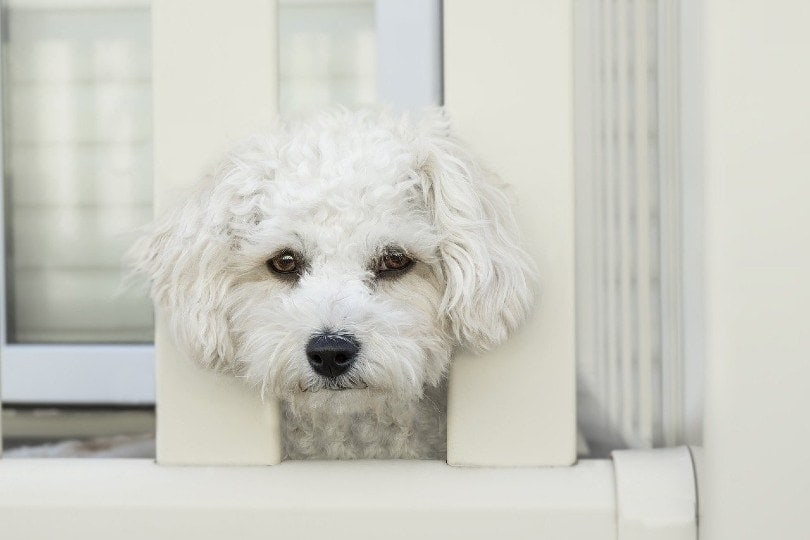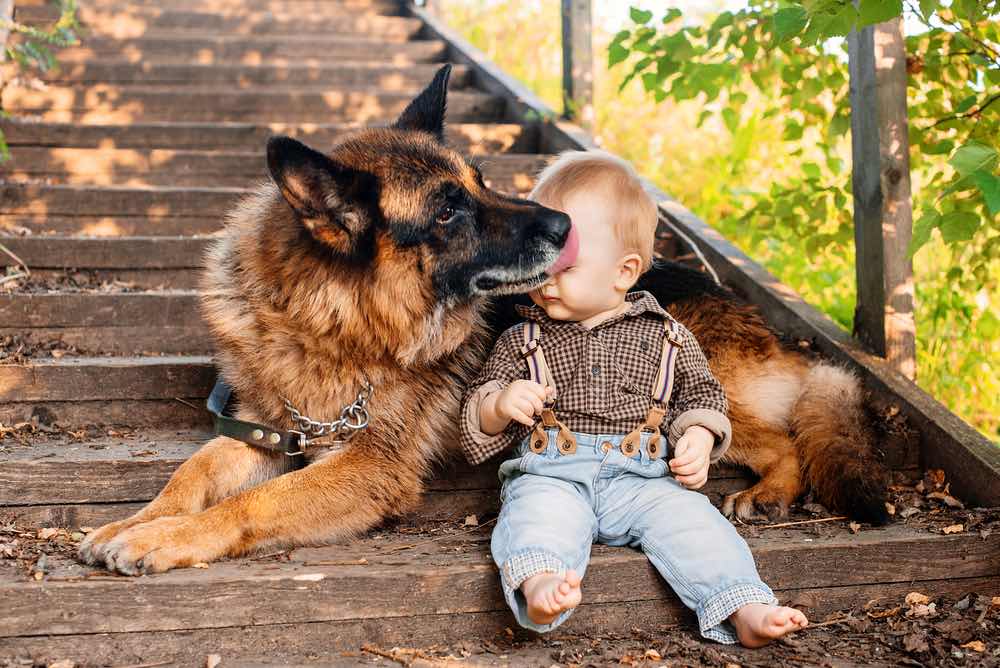Boredom and Little Mental Stimulation
Your dog could probably be bored and needs some mental stimulation. It’s essential to play with your canine friend or take it for walks and exercise often. If the dog is not getting the recommended exercise, it could quickly get boring.
You become the sole source of entertainment in the house, which makes them follow you around. If you keep the dog inside the house for long periods, the clinginess intensifies.
Some dogs experience separation anxiety when the owner is not around. This dysfunctional hyper attachment causes the dog to become agitated when separated from its owner. The anxiety is triggered when you are preparing to leave the house or going to bed.
The reaction can be pacing, increased barking, sadness, depression, or sudden panic. Dogs with separation anxiety exhibit some significant symptoms. They could urinate and defecate in the house, chew off household items, or tear off furniture.

If your dog is sick, they may depend on you as a source of comfort. During a sickness period, the dog may be confused, which causes it to develop clingy behaviors. Observe whether there are any underlying health conditions when your dog starts following you around suddenly.
Furthermore, especially if your breed is old, they may be developing hearing or vision problems. These medical problems can be scary for them, so they choose to come to you as a coping mechanism.
Older dogs may also have canine dementia or Canine Cognitive Dysfunction Syndrome (CCDS), contributing to their clinginess. These conditions increase irritability. Once you notice any of these issues, it’s best to make an appointment with your veterinarian.
Naturally, dogs have been bred to be human companions. Your pet may be following you everywhere because it’s naturally inclined to hang out with you rather than other dogs. Over the years, domestication has continued to evolve, and humans are now bonding with dogs more, especially from a young age.

Have you just moved to a new house or neighborhood? This could be why your dog is not leaving your side. You may also have a new addition to your family, which interrupts the dog’s routine.
Significant life changes can be stressful to your dog pet and cause increased anxiety. In this case, the dog will choose to stick by the human they know most.
In some cases, your pet becomes clingier if you are pregnant. Once it notices changes in the human body, it tends to become protective. Following you around provides a source of comfort and stability which can eventually become clingy.
If your pet is afraid of activities happening outside your houses, such as fireworks or other pets, it will stick by your side. Observe moments when the dog follows you around to determine whether it’s a result of fear.

Naturally, humans will reward a dog for specific things. Pets get treats, food, toys, or extra attention for positive behaviors. They would also get involved in fun activities as a reward for human companionship.
As soon as your canine friend understands these behaviors, they will tend to stick by your side to receive rewards more often. A pat on the head or an occasional treat would trigger the dog to behave more positively. This sparks a co-dependency that can become unhealthy.
Reason #7 – Issues With Other Pets In The House
Dogs are social animals who are going to seek out interaction with who and whatever they can. Still, some dogs just don’t like other dogs.
It’s possible that your dog has had a run-in with one of the other animals in the house and they are clinging to you for help support.
Maybe your cat finally decided that THEY wanted that cozy bed under the window and pushed your dog out.
Your dog, knowing that he’s not allowed to chase the cat, may come to you and follow you around because they don’t know what to do and need you to come help, not unlike dealing with squabbling children.
If you have an exotic pet, you should be extra scrutinizing of their relationship with your dog. While your Bassett Hound and your Tegu may seem like fast friends when you’re in the room, they may have a whole different relationship when you aren’t around.
Most pet parents are at least aware of the fact that many dogs are highly sensitive to bad weather, particularly thunderstorms with a lot of electricity in them.
While many pet parents chalk their dog’s sensitivity up to just sensitivity or a misunderstanding of the bad weather, it’s important to know that your dog may actually be physically experiencing that thunderstorm in a way that you can’t even fathom.
We now know that dogs can sense the barometric pressure changes that come with changing weather patterns. They can also sense the static electricity in the air that accompanies thunderstorms.
You’ll often find dogs hanging out in the bathroom during thunderstorms because porcelain diffuses electricity in the environment. They are seeking out a room in the house that has less static electricity going on in it.
And their senses of smell, which are about 40 times better than ours, means that they can smell the rain and the water splattering outside. If you can smell the rain, think how strong that must be to your dog?
All of this combines to be a really weird experience for your dog, so it should come as no surprise that they’d follow you around if the weather is bad outside.
Every time my dog gets sick, she looks at me with this sad little face that just screams “dad, fix it!”
She’s convinced that I can somehow make it better. After all, when she’s hungry, I fix that. When she needs to go potty, I help her with that. Thirsty, bored, excited, I do it all!
Your dog may be suddenly following you around because they have a physical ailment. They may be aware that they are sick and are actively asking for help, or they may just feel bad and are following you around looking for relief.
Your dog will likely have some other obvious signs of illness, but not necessarily.
While your dog is probably following you around because of some emotional or behavioral reason, it is entirely possible that they are very seriously ill. Do not take any sudden change in your dog’s behavior lightly.
It can be hard for many pet parents to admit or recognize when their life-long buddies are starting to get old. It can seem so unfair that they get old so much faster than we do, but such is the nature of our relationship with dogs.
It depends a lot on the individual dog, particularly the breed and the size, but most dogs are considered “senior” once they reach 8 years old.
While following you around may seem like a strange thing for an old dog to do, it’s actually a very common sign of dementia in both humans and dogs.
Developing and living with dementia can cause deep feelings of insecurity, especially for a poor dog who doesn’t have the capacity to understand why they are disoriented or why they do not remember where they are.
Because of this, both humans and dogs who develop dementia are prone to trailing, following, and checking with others in the house who they recognize.
If your dog is over 8 years old and has suddenly started following you around and refusing to leave your side, they may be developing dementia or another age-related ailment.
Like I mentioned, dogs are creatures of habit. Left to their own devices, dogs set a remarkably reliable schedule.
The flip side of this is that they are highly sensitive to changes in their routine, especially changes to some of the pillars of their schedule.
Some changes in your home that may have caused your dog to suddenly start following you around that you may not have noticed include:
Finally (and this one probably doesn’t apply to most of you readers but I’ve got to cover all the bases), an unspayed female dog in heat is more likely to be clingy and refuse to let you leave their side.
You surely know if your adult female dog is unfixed but many puppy-owners are surprised by their dogs’ first heat cycle.
A female dog will have their first heat cycle at roughly 6 months old and will continue to have them twice a year for the rest of their life.
During this time, their hormones go absolutely nuts. Along with many other side effects, they may end up becoming more clingy and emotionally attached to their owners during this time.
Why is my dog so obsessed with me?
Often called clingy, velcro dogs have a desire to be close to their owners. Companionship. Perhaps the most obvious reason, some dogs simply prefer the companionship of their human owners. Over the process of domestication, natural selection has shaped dogs to become companions for humans.
14 Signs Your Dog Doesn’t Love You (Even if You Think They Do)
Recently, it seems that no matter where you go, your dog is right there by your side.
Now, normally this wouldn’t be considered a bad thing. On the contrary, who wouldn’t want a loyal companion that’s there for them through thick and thin?
If only they would just let you out of their sight long enough for you to go to the toilet without them staring at you the whole time.
If you’re here wondering, “Why is it that my dog won’t leave my side?”, there are actually numerous possible reasons that can explain this.
From their genetics to possible health and behavioral issues, let’s look into some of the reasons as to why your dog might be constantly glued to your side.